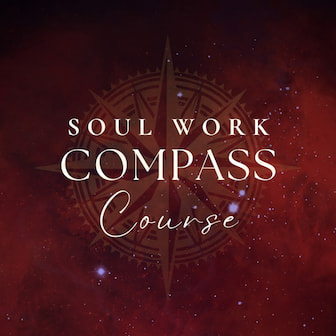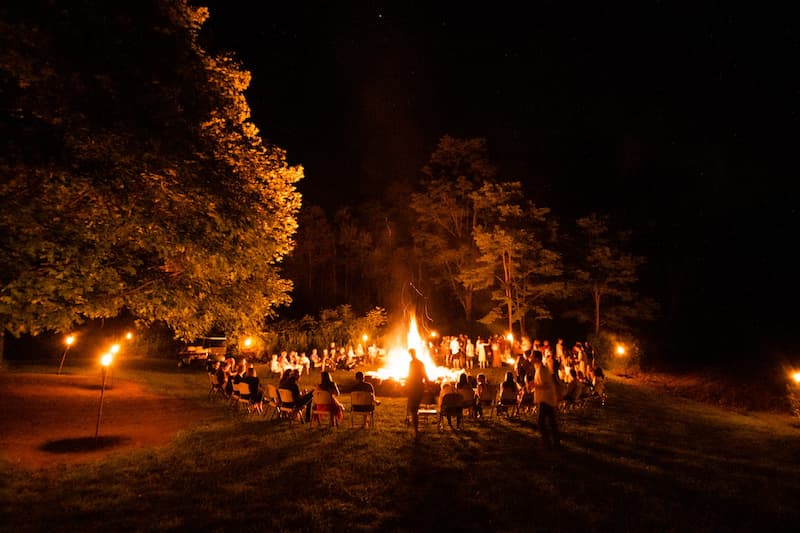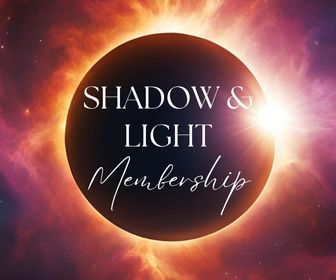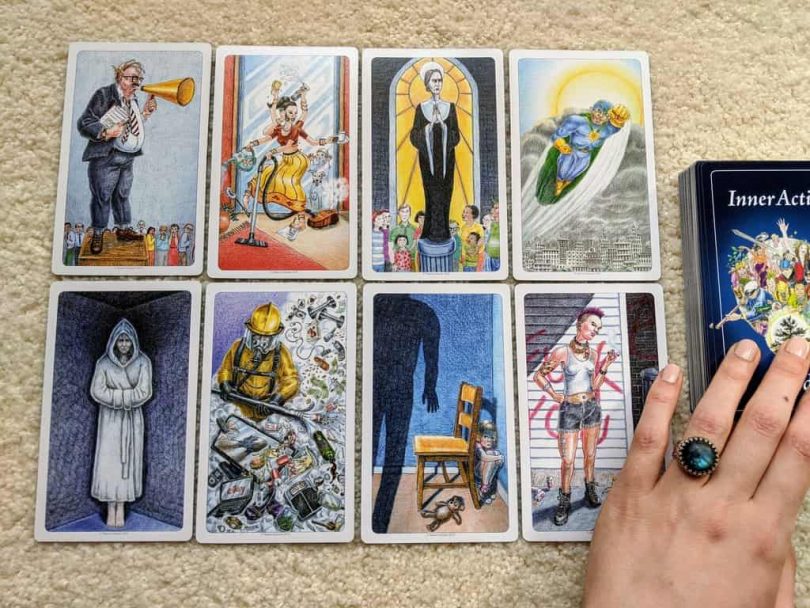Of all the psychological and spiritual tools out there, Internal Family Systems (IFS) is one of the most powerful.
Never heard of it? That’s okay. Most people haven’t. And my intention is to change that.
Ignore the complicated-sounding name for a sec and hear me out:

Soul Work Compass Course:
Feeling lost or disconnected? The Soul Work Compass guides you through a 12-lesson alchemical journey to transform emptiness into clarity and deep self-insight. Create your personal compass to navigate life with clarity, freedom, and soul-aligned direction. Start your Great Work today!
Internal Family Systems (IFS) is such a useful inner soul work approach because it helps us to create inner balance and rediscover our spiritual Wholeness.
In fact, I have found IFS so useful on my spiritual awakening path that I regularly use its approach to practice mindful self-compassion and soul retrieval (aka., integrating disconnected parts of the psyche).
Want to learn the basics of IFS? Keep reading, and I’ll walk you through it …
Table of contents
What is Internal Family Systems?

Also referred to as Parts Work, Internal Family Systems is a form of psychotherapy that focuses on reintegrating and harmonizing the inner parts of us (also known as our subpersonalities). Developed by Richard C. Schwartz in the 1980s, Internal Family Systems is based on the premise that we all contain an inner family composed of many different parts. At the core of ourselves exists a wise, calm, and loving Self that we can seek to reunite with during this therapeutic process.
We All Have an Inner Family

As professor and author Tom Holmes writes, we all have an inner family composed of different parts:
In the Buddhist tradition these states are called mental formations or habit patterns. Piaget and the cognitive behaviourist refer to them as schemas. Psychosynthesis refers to them as sub personalities and psychodynamic psychologists refer to them as ego states. We will call them ‘parts.’
While some of these inner parts help to protect and motivate us, other parts are highly destructive and dysfunctional. The purpose of IFS is to bring harmony to our inner family of parts, reinstating our core Self (the wise and loving part of us) as the head of this inner family.
Examples of Inner Parts That Most of Us Contain

The core purpose of Internal Family Systems is to help us clearly identify and work with our parts so that we can approach life mindfully, seated in our wise and compassionate Center (or Self).
Common parts that most of us contain include, for example:

Shadow & Light Membership:
⭐️⭐️⭐️⭐️⭐ "Straight from the very first weekly email, this has been mind-blowingly powerful, the synchronicity and the on-vibe contents resonate uncannily with my soul’s current challenges." – Marie
- A magical child part
- A wounded child part
- A motherly/fatherly part
- A sensual part
- An angry part
- A rebellious part
- An insecure teenage part
- A lazy part
- A practical part
- A gluttonous part
- A problem-solving part
- An innocent part
- A judgmental part
- A self-destructive part
- An adventurous part
- … and so forth
There are virtually an unlimited number of parts that we contain. At any one time, a handful of parts might be activated within us, but usually, we’re operating in only one or two parts at a time (e.g., the responsible adult part, the mother part, the student part).
What Happens When Our Inner Parts Become Destructive?

When our inner parts become destructive (aka., when they sabotage our dreams, harm others, or perpetuate mental and emotional illness), it is as if we become possessed by them.
Internal Family Systems therapy calls this becoming blended with these parts.
Blending happens when a part overtakes our consciousness, and we temporarily become it. For example, we might declare, “I want to KILL him,” in a moment of anger and genuinely feel that desire. A more centered approach is thinking, “A part of me wants to kill him.”
The solution to this dilemma is to become unblended, that is, to find a way to step back, see what part is taking over, and perceive it from the wise and compassionate viewpoint of the central Self.
In other words, Internal Family Systems is all about returning us to our True Nature and reconnecting us with our Souls. It is a sublime mix of psychology and spirituality and is, therefore, an invaluable practice on our spiritual journeys.
3 Types of Parts That Are Wreaking Chaos Inside of You

Our inner parts can either be healthy or unhealthy. (And, of course, there are some that are a little bit of both.)
When doing Parts Work, we’re exploring the chaotic, wounded, and dysfunctional parts of you. These parts tend to take on one of three main roles:
- Managers – These are parts of us that organize and protect our system. Their job is to help shield and safeguard us from the external and internal world and suppress the pain of our inner Exiles (which we’ll explore below). Manager parts tend to be controlling, perfectionistic, intellectual, obsessive, critical, reclusive, emotionally detached, hypervigilant, phobic, and tend to suffer from anxiety and depression.
- Firefighters – These are parts of us that will do anything to make the pain go away (that our inner Exile parts carry). They’ll not only put out the fire of pain within us, but they’ll also destroy the whole house in the process if necessary. Their role is to stop us from feeling anything too painful, but unlike Manager parts, Firefighter parts go to the extreme. Firefighter parts tend to be impulsive, illogical, addictive, and destructive and will extinguish anything that is associated with our trauma by any means possible.
- Exiles – These are the lost and buried parts within us that carry trauma. Manager parts try to keep these parts of us at bay by distracting and administrating our daily lives (through work, responsibilities, self-judgment, etc.). On the other hand, Firefighter parts within us try to keep Exile parts away through extreme means such as addictions, purging, self-harm, affairs, etc. – this is done in a desperate attempt to protect our system. As a result of being suppressed by our inner Managers and forcefully withheld by our Firefighters, Exile parts often try to escape their prison cells. Their deepest desire is to be loved, yet they are frozen in the past. They are defined by feelings of terror, rage, helplessness, and collapse.
To make matters more difficult, there can be internal conflict between these inner parts. For instance, Managers can fight Firefighters (and vice versa), and of course, Managers and Firefighters actively fight against our inner Exiles.
So, how do we work with these dysfunctional parts?
Would you like to save this?
Your information will never be shared.
Download FREE IFS Worksheets!
Go deeper with an Internal Family Systems journaling prompt + printable meditation mandala!
How to Connect With Your Soul Through Parts Work (Internal Family Systems)

To create inner psychological and spiritual balance, we need to become unblended from these inner parts and learn to step into our Self, which is our True Center.
Your core Self is the eye of the storm, the non-judgmental, creative, curious, wise, and relaxed part of you that holds all these conflicted parts within you in the arms of self-compassion.
To connect with this Self (which is another way of saying your Soul), you will need to practice becoming mindful of the different parts within you.
Healing, which is a natural result of operating from your Soul Center, means identifying, acknowledging, appreciating, and learning about your inner parts and becoming unblended from them.
By learning to stay within your Soul Center (Self), you will create more safety within your system, which will help to bring your inner Managers and Firefighters back into balance, welcoming back the presence of your lost Exile parts.
While this all may sound complex, it’s not. Of course, I recommend seeking out a trained Internal Family Systems therapist if you’re dealing with severe issues. But if you’re having mild difficulties, doing Parts Work is quite a straightforward process and, in my opinion, quite enjoyable at times!
Don’t expect to get instantaneous results or to be good at Parts Work immediately. Instead, see this process as a long-term ongoing practice that can support your psychological and spiritual growth.
Here are a few simple ways of beginning Parts Work:
1. Become familiar with your inner family

What parts dominate your internal landscape? Answering this question is the best way to begin Parts Work and, therefore, reconnecting with your Soul. If you can’t distinguish your inner parts from each other, it will be hard to unblend from them and be Soul-led.
To start this practice, think about a situation in life that created a strong reaction within you. It’s also okay to start small with this activity. Connect with a thought, feeling, or memory of something that upset you. Perhaps someone shouted at you while you were driving the other day. Perhaps your co-worker did something behind your back. Whatever it is, connect with that memory/feeling/thought.
Next, notice the feelings in your body that accompany this distressing situation. What kind of thoughts do you have surrounding this circumstance? If you were to give an image to this part of you, what would it look like? Feel free to incorporate journaling into this practice.
You might, for example, reflect on an argument you had with your partner the other night. Perhaps as you tune in, you feel a sense of smallness and constriction in your body. You might have thoughts such as, “S/he will never understand me. I’m all alone.” An image might form in your mind of a petulant teenager – and this is the part of you that was active during the argument.
You can also become familiar with your inner family by reflecting on your daily life. What primary roles do you play? What emotions dominate your inner landscape during the day? What are your goals, dreams, and interests? What are you afraid of? These questions will help you to reveal your inner parts.
You can learn about how to establish a journaling practice in my how to journal article.
2. Practice naming and greeting your inner parts

The more familiar you become with your inner family of parts, the more you will be able to name and greet them mindfully – without getting possessed by them.
At different moments of the day, make a habit of pausing, connecting with your breath, and noticing what part is active within you at the moment. Then, greet that part with kindness. This is a simple Soul-centered practice that will help you to reconnect with your Soul gradually.
For over 12 years, we've poured our hearts into creating free content on this website. Unlike many platforms, we believe this guidance should be accessible to everyone. If this post empowered you in any way, please consider making a donation to keep us going. Any amount (one-time or ongoing) makes a huge difference.
For example, you might mentally pause while driving and observe what’s going on within you. You might observe your mind worrying about a work assignment and how you’re going to get it done. As you take a step back from that part, you may like to greet this Worry part with kindness, saying a simple, “Hello there, Worry part, thanks for stopping by.”
In response to this practice, you might notice other parts within you emerging with a vengeance (after all, their job is to try and protect your ego from any perceived changes/threats). You might notice an inner Skeptic part mocking your practice of naming and greeting inner parts. Or you may notice an inner Critic, Judge, or Bully trying to take over your consciousness again. Simply name and greet these parts with kindness.
If you work best with visual aids, I highly recommend looking into getting yourself the Inner Active Cards deck. This is a fantastic way of familiarizing yourself with the different parts of yourself in a fun, interactive way.
3. Connect with your inner Self (Soul) every day

The beauty of the Internal Family Systems practice is that it emphasizes the central importance of the Self or Soul – and also that identifying, acknowledging, appreciating, and learning about your inner parts creates more inner psychological and emotional clarity. This inner clarity will make it easier to live more and more from the warm and serene seat of the Self/Self. It’s a beautiful psychospiritual system!
To connect with your inner Self or Soul each day, there are a number of practices you can try:
- Do a Metta (lovingkindness) or heart-centered meditation every morning
- Pause throughout the day and mindfully connect with your breath
- Practice self-love in conjunction with mirror work
- Use art to express your inner Self (drawing mandalas is a wonderful place to start)
- Make space for introspective and reflective journaling to increase inner clarity
- Spend time practicing self-forgiveness
- Connect with your inner Spiritual Guide part to help you stay Soul-centered (you can do this through a self-guided meditation)
- Sign up to our Shadow & Light membership, which incorporates IFS principles amongst other practices for ongoing spiritual guidance, accountability, and healing!
This is not an exhaustive list, but there are some good suggestions here to help you get started.
The more familiar you become with that clear, calm, compassionate, curious, and wise Center within you, the more you will live in a state of balance. Instead of your inner parts overriding your consciousness, you’ll be able to become aware of them, treating them with love and respect (without blending with them).
***
I hope that I’ve inspired you to dive more deeply into this wonderful topic.
Internal Family Systems or Parts Work is a powerful tool for all those who recognize the importance of honoring our humanity and divinity. Psychology and spirituality are two sides of the same coin, and both are needed in order to find balance, joy, peace, and freedom – we’ve written more about this need for a psychospiritual approach in our spiritual psychology article.
To have a clear mind is to have a clear body and heart and, therefore, a clear access to your Soul. Parts Work practice is one of the best ways to find this clarity.
For extra guidance, I highly recommend checking out Tom and Lauri Holmes’ book “Parts Work: An Illustrated Guide to Your Inner Life” or “Introduction to Internal Family Systems” by Richard Schwartz
Tell me, what does your internal family look like? Who are the main players? I’d love to hear from you.
Two paths to inner transformation – here’s how I can help you go deeper:
1. The Soul Work Compass Course: Feeling lost or stuck in repetitive cycles of pain? The Soul Work Compass Course is your guide to reclaiming your true purpose. In this deep yet practical journey, you’ll learn how to heal core wounds and create a tangible "Soul's Compass" to navigate life with clarity. Enroll now and find your True North!
2. The Inner Work Journal Bundle: Ready for deep transformation? This bundle includes three powerful journals – Self-Love, Inner Child, and Shadow Work – with 150+ prompts to heal wounds, integrate your darkness, and experience bone-deep change. Digital & printable. Print unlimited times.







Is there a good IFS therapist you would reccomend in California? Would appreciate any reccs. Thank you!
Hey Christina, I’d recommend looking through their official directory of licensed therapists as you can narrow it down by state and city: ifs-institute.com/practitioners/
Thanks for once more creating an interesting motivational and instructive post 💓
Thanks John!
Are they constructive, destructive, or just annoyingly restrictive to my system?
To do this builds a better clearer mindset, better internal modes and practice,
where self-respect and truth prevail. 😎
These are some interesting questions and reflections John. Thanks for sharing! One thing I want to point out is that IFS isn’t about choosing “good” parts over “bad” parts (in fact, there is an amazing book literally called “No Bad Parts” that I recommend you get your hands on). Instead, it’s about seeing that all parts, even the seemingly destructive or dark ones, have hidden value and gifts. They are all trying their best to protect us in various ways, shapes, and forms (some in quite harmful ways). To me, accepting all aspects of us is much more integrative and healing then picking and choosing (which sounds good in theory, but in reality life doesn’t work that way as there will often be situations where difficult parts re-emerge). I hope that helps to clarify IFS a bit more. :)
This makes the Buddhist concept of mental formations a bit clearer to me, incidentally. Thanks for that.
The solution to blending described here may be called discernment, an important skill for anyone on a spiritual path. As addressed, we should be able to name which part is being blended.
It seems to me that Managers, Firefighters, and Exiles should be renamed Enablers, Arsonists and Prisoners, about the opposite of what they are named already. Consider what our first responders would say. If we are working in a Buddhist-rooted mode, let’s consider addressing our connections, even metaphorical ones, in a compassionate way.
The word “possess” is also problematic. It needs to be clear that the parts of ourselves are not external entities that attach to our bodies. This would distinguish a circumstance that should (and would) cause immense fear instead of a simple meditation. If we make any part of ourselves an enemy, this is disassociation, which undermines any practice.
Thanks for these insights Mason. There is indeed a big overlap between IFS and Buddhist ideas, with the exception of concepts like the Soul which Buddhists, if I recall, don’t believe in.
As for using the word “possess” I’m not sure if I wrote that in the article, but if I did, a clearer description would be “blend.” Parts can blend with us and IFS is about in unblending, unburdening, and integrating them so that we can be Self or Soul-led. As you point out, the language we use is important and a compassionate approach is the key here :)
I appreciate your saying so. I fear I can come off as blunt.
How does IFS overlap or stand apart from ego, shadow, inner child, inner critic, etc? Are these all considered “parts” and accompanied by IFS or is it not that straightforward?
There are many such parts of ourselves. A recurring goal of spirituality is to recognize, heal and integrate them in a healthy way. Some are easier to work with than others, and an especially effective starting point is with the inner child. Interfacing with the ego and shadow directly are intermediate or advanced. I recommend Mary Shutan’s Spiritual Awakening Guide for a practical map.
Great questions Jackie! IFS has a beautiful way of bringing all these aspects together and putting them into a framework. Exiles in IFS are what we also refer to as the shadow (or our various shadows). Often our inner child is an exiled shadowy part. Shadow self is an umbrella term for anything within us, light or dark, that we don’t have much knowledge or awareness of. The ego, inner critic, and so on are the manager parts that try desperately to run the show and stay in control. Our firefighter parts are extreme tendencies of us that try to suppress our pain and traumas like binge eating parts, self-harming parts, drug addicted parts, social media obsessed parts, and so on. Does that help?
Yes, that is very helpful! I purchased the Parts Work book you mentioned and was flipping through it last night and starting to get a handle on this^ but your explanation was VERY helpful. Thank you! This is a really great article and found me at a very serendipitous moment :)
Dear Aletheia & Mateo,
So excellent that you brought IFS to your community.
I’ve connected with this modality about a year ago, and attended virtual talks with
Dr. Richard Schwartz,
where he explained how this is used as a therapeutic tool,
to empower the “I” to harness the tendencies of each part,
with self-compassion, understanding and emotional regulation
(on the email list for the organization)
and Yes it is one of best manners to become aware of one’s patterns of behaviour and thinking,
without judgement, with curiosity
Also – Dr. Richard Schwartz
has partnered with
Thomas Huebl – who is about Relational Attunement
to apply IFS to communities, and even to society/humanity overall
Wonderful! Thanks for sharing this Larissa 😊 The partnering with Huebl sounds exciting!
I’m a huge fan of IFS!!! “No Bad Parts” is a great read. Schwartz also recently published a new IFS book “You are the one you’ve been waiting for”. Deeply powerful stuff.
Thank you for sharing info about it in this context of practicing soul work. Really pulls it all together for me :)
Next book on my to-read list! Thanks Kellan 😄
Another wise and healing article from you, thank you so much.
May I add that Richard Schwartz published a great book in 2021 that is very accessible for non-professionals who want to work with IFS: “No bad parts”. Highly recommended!
Thank you. 💕
Yes, it’s an excellent book! I’m currently reading it. Thanks Nika 💜